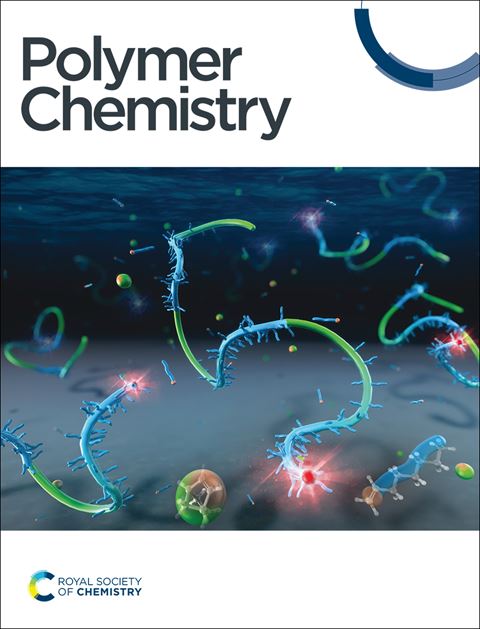Revisiting AB2 + A-R copolymerization: direct access to Janus and peripherally clickable hyperbranched polyesters†
IF 3.9
2区 化学
Q2 POLYMER SCIENCE
引用次数: 0
Abstract
Hyperbranched polymers (HBPs) are often prepared by the self-condensation of AB2 type monomers, which results in compact globular structures with numerous B-groups on their periphery; the number of terminal B-groups increases with the DPn value of the polymer. Since the AB2 monomer has one equivalent of B-group in excess, copolymerization with up to one equivalent of an A-R-type molecule provides direct access to HBPs whose periphery is decorated with the desired R-unit. Here, we demonstrate that direct melt condensation of a simple AB2 monomer, dimethyl 5-(6-hydroxyhexyloxy)isophthalate (DMHHI), with MPEG-OH (A-R1) and/or cetyl alcohol (A-R2), generates peripherally decorated HBPs. When two different A-R molecules are used together, the relative amounts installed are controlled by the mole ratio of the two, taken during the polymerization. We show that the terminal methyl ester groups in the HBP are almost completely replaced (>95%), making this a very effective and direct strategy for peripheral installation of multiple segments. Importantly, we show that when alkyl and PEG segments are co-installed, self-segregation occurs to generate a Janus structure, with evidence for this being obtained from DSC and X-ray scattering studies. Furthermore, we also demonstrate the direct synthesis of peripherally clickable HBPs using this AB2 + A-R copolymerization strategy, wherein 10-undecen-1-ol or 10-undecyn-1-ol is used as the A-R comonomer. The terminal unsaturation is then used to install PEG segments, using radical-initiated thiol–ene or thiol–yne click reactions, to yield core–shell-type amphiphilic structures. As expected, aqueous solutions of shell-PEGylated HBPs exhibited an LCST, and the transition temperatures increased with the length of the PEG segment and its number density within the shell region. This general copolymerization approach is scalable and can readily be extended to install different types of functional motifs on the periphery of globular hyperbranched constructs, thereby providing opportunities for a variety of potential applications.

重新审视AB2 + A-R共聚:直接接触Janus和外围可点击的超支化聚酯
超支化聚合物(HBPs)通常是由AB2型单体的自缩合制备的,这导致了紧凑的球状结构,其外围有许多b基团;末端b基团的数量随着聚合物的DPn的增加而增加。由于AB2单体有一个多余的b -基团等效物,与多达一个等效物的A-R型分子共聚提供了直接进入HBPs的途径,HBPs的外围被所需的r -单元修饰。在这里,我们证明了一个简单的AB2单体,二甲基5-(6-羟基己氧基)间苯二甲酸酯(DMHHI),与MPEG-OH (a - r1)和/或十六醇(a - r2)直接熔融缩合,生成外周修饰的HBPs;当两种不同的A-R分子一起使用时,安装的相对量由聚合过程中两者的摩尔比控制。我们发现HBP的末端甲酯基团几乎完全被取代(95%),这使得它成为一种非常有效和直接的多节段外围安装策略。重要的是,我们表明,当烷基和PEG片段共同安装时,会发生自离析,产生Janus结构;DSC和x射线散射研究证明了这一点。此外,我们还证明了使用这种AB2 + A-R共聚策略直接合成外缘可点击的HBPs,其中10-十一烯-1-醇或10-十一烯-1-醇被用作A-R共聚单体;然后利用末端不饱和来安装PEG片段,利用自由基引发的硫醇烯或硫醇炔点击反应,得到核壳型两亲性结构。正如预期的那样,壳聚乙二醇化HBPs的水溶液表现出LCST,并且随着PEG片段的长度和壳区内PEG片段的数量密度的增加,转变温度升高。这种通用的共聚方法是可扩展的,可以很容易地扩展到在球状超支化结构的外围安装不同类型的功能基元,从而为各种潜在的应用提供了机会。
本文章由计算机程序翻译,如有差异,请以英文原文为准。
求助全文
约1分钟内获得全文
求助全文
来源期刊

Polymer Chemistry
POLYMER SCIENCE-
CiteScore
8.60
自引率
8.70%
发文量
535
审稿时长
1.7 months
期刊介绍:
Polymer Chemistry welcomes submissions in all areas of polymer science that have a strong focus on macromolecular chemistry. Manuscripts may cover a broad range of fields, yet no direct application focus is required.
 求助内容:
求助内容: 应助结果提醒方式:
应助结果提醒方式:


